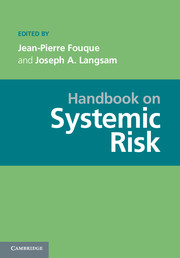Book contents
- Frontmatter
- Contents
- Contributors
- Introduction
- PART I DATA: THE PREREQUISITE FOR MANAGING SYSTEMIC RISK
- PART II STATISTICS AND SYSTEMIC RISK
- PART III MEASURING AND REGULATING SYSTEMIC RISK
- PART IV NETWORKS
- PART V SYSTEMIC RISK ANDMATHEMATICAL FINANCE
- PART VI COUNTERPARTY RISK AND SYSTEMIC RISK
- PART VII ALGORITHMIC TRADING
- PART VIII BEHAVIORAL FINANCE: THE PSYCHOLOGICAL DIMENSION OF SYSTEMIC RISK
- PART IX REGULATION
- PART X COMPUTATIONAL ISSUES AND REQUIREMENTS
- PART XI ACCOUNTING ISSUES
PART I - DATA: THE PREREQUISITE FOR MANAGING SYSTEMIC RISK
Published online by Cambridge University Press: 05 June 2013
- Frontmatter
- Contents
- Contributors
- Introduction
- PART I DATA: THE PREREQUISITE FOR MANAGING SYSTEMIC RISK
- PART II STATISTICS AND SYSTEMIC RISK
- PART III MEASURING AND REGULATING SYSTEMIC RISK
- PART IV NETWORKS
- PART V SYSTEMIC RISK ANDMATHEMATICAL FINANCE
- PART VI COUNTERPARTY RISK AND SYSTEMIC RISK
- PART VII ALGORITHMIC TRADING
- PART VIII BEHAVIORAL FINANCE: THE PSYCHOLOGICAL DIMENSION OF SYSTEMIC RISK
- PART IX REGULATION
- PART X COMPUTATIONAL ISSUES AND REQUIREMENTS
- PART XI ACCOUNTING ISSUES
Summary
Data for Systemic Risk
Whatever models may be constructed to assess systemic risk, they will require data to evaluate. This Part of this book explores the data needs for evaluating systemic risk, and describes the many challenges in meeting these data needs effectively.
Systemic risk models are particularly complicated because they are aggressively non-linear – an entity is either able to meet its contractual obligations or it is not, and which of the two scenarios we are in can affect the solvency of many other entities – and furthermore have heavy interlinkage between model entities so that independence assumptions are almost never possible. In consequence, the common mathematical simplifications, of linearity and independence, cannot be made. This leads to the need for models that are far more complex, potentially require Monte Carlo simulations to solve, and rely upon a large body of data and computation. In short, a large variety of detailed (granular) data is likely to be required, from a range of market participants. The size of this dataset makes computational assessment imperative: its complexity makes purely computational evaluation challenging. The five chapters in this Part together elucidate this challenge and also suggest directions toward a solution.
- Type
- Chapter
- Information
- Handbook on Systemic Risk , pp. 1 - 8Publisher: Cambridge University PressPrint publication year: 2013



